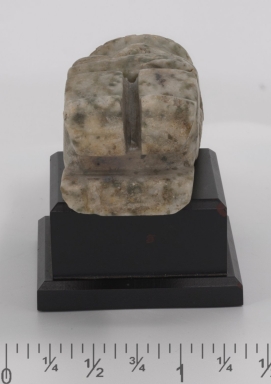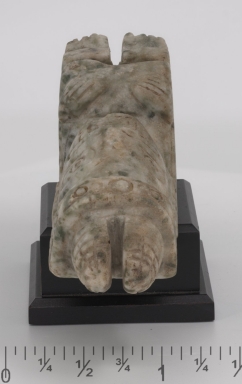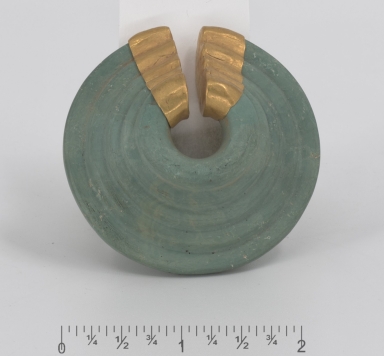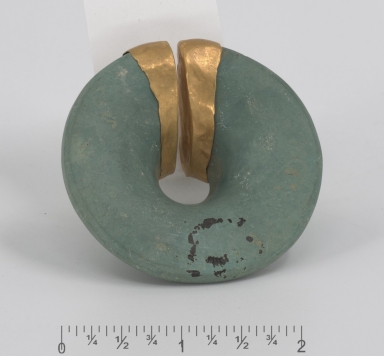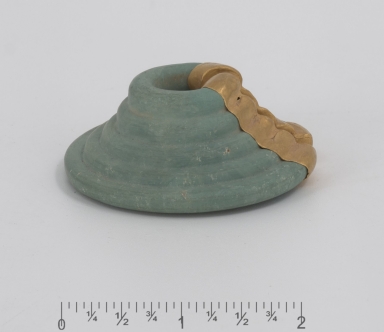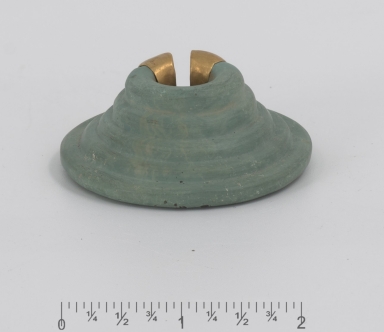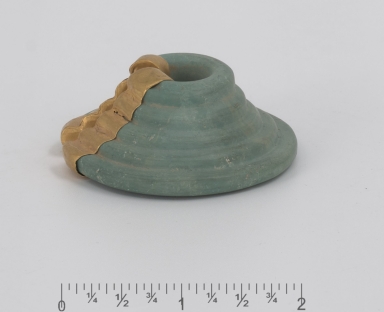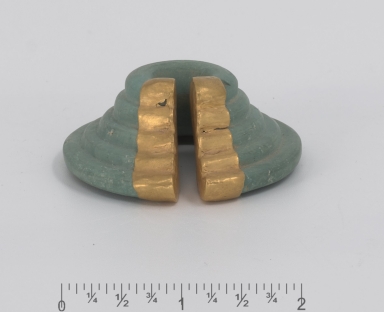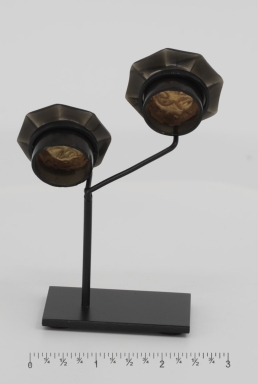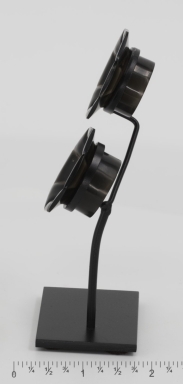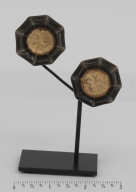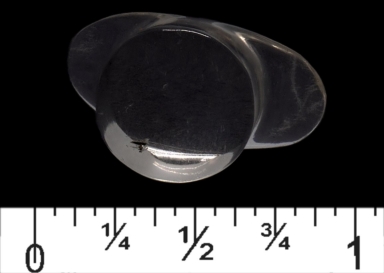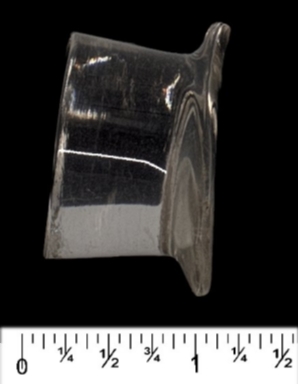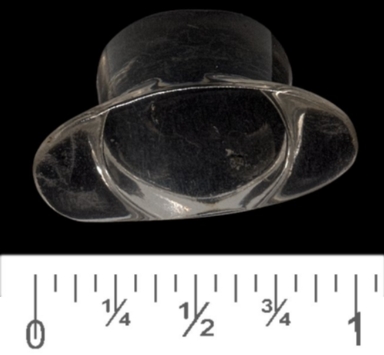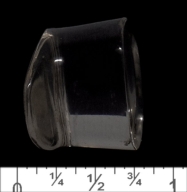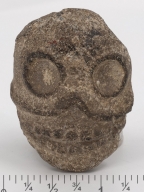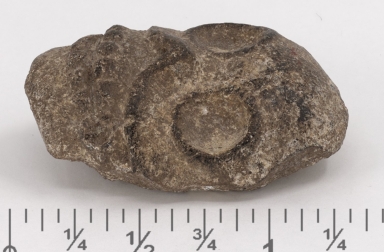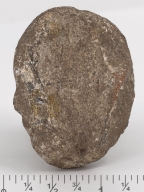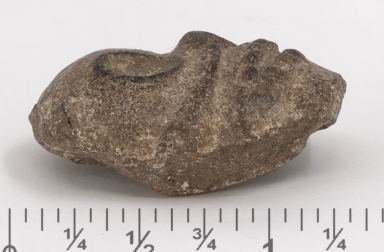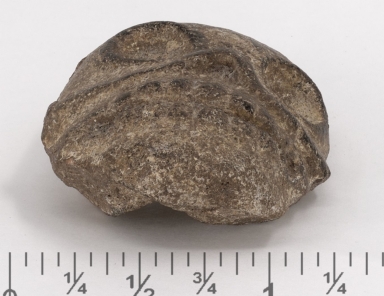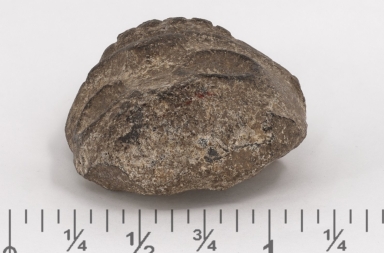|
|
REFINE
Browse All : Artifact and Stone carving--Mexico--Oaxaca (State)
1-27 of 27
Title
Penate : seated stylized human figure wearing a mask and a maize headdress.
Description
The Mixtec sculpture represents a man squatting on the ground with his arms folded on top of his knees. These sculptures called penates are usually small personal amulets. The form of the body remains rectangular and divided into three square areas. They were mass produced for personal use. This large penate is unusual, because he wears a mask and a corn headdress. The Aztec name for this God is Centeotl, the young male corn God.
Subject
[Stone carving--Mexico--Oaxaca (State), Sculpture--Mexico--Oaxaca (State), Mixtec art--Mexico--Oaxaca (State), Indigenous peoples--Antiquities]
Date
between 1260 and 1521
Title
Penate : seated stylized human figure wearing a mask and a maize headdress.
Description
The Mixtec sculpture represents a man squatting on the ground with his arms folded on top of his knees. These sculptures called penates are usually small personal amulets. The form of the body remains rectangular and divided into three square areas. They were mass produced for personal use. This large penate is unusual, because he wears a mask and a corn headdress. The Aztec name for this God is Centeotl, the young male corn God.
Subject
[Stone carving--Mexico--Oaxaca (State), Sculpture--Mexico--Oaxaca (State), Mixtec art--Mexico--Oaxaca (State), Indigenous peoples--Antiquities]
Date
between 1260 and 1521
Title
Penate : seated stylized human figure wearing a mask and a maize headdress.
Description
The Mixtec sculpture represents a man squatting on the ground with his arms folded on top of his knees. These sculptures called penates are usually small personal amulets. The form of the body remains rectangular and divided into three square areas. They were mass produced for personal use. This large penate is unusual, because he wears a mask and a corn headdress. The Aztec name for this God is Centeotl, the young male corn God.
Subject
[Stone carving--Mexico--Oaxaca (State), Sculpture--Mexico--Oaxaca (State), Mixtec art--Mexico--Oaxaca (State), Indigenous peoples--Antiquities]
Date
between 1260 and 1521
Title
Penate : seated stylized human figure wearing a mask and a maize headdress.
Description
The Mixtec sculpture represents a man squatting on the ground with his arms folded on top of his knees. These sculptures called penates are usually small personal amulets. The form of the body remains rectangular and divided into three square areas. They were mass produced for personal use. This large penate is unusual, because he wears a mask and a corn headdress. The Aztec name for this God is Centeotl, the young male corn God.
Subject
[Stone carving--Mexico--Oaxaca (State), Sculpture--Mexico--Oaxaca (State), Mixtec art--Mexico--Oaxaca (State), Indigenous peoples--Antiquities]
Date
between 1260 and 1521
Title
Penate : seated stylized human figure wearing a mask and a maize headdress.
Description
The Mixtec sculpture represents a man squatting on the ground with his arms folded on top of his knees. These sculptures called penates are usually small personal amulets. The form of the body remains rectangular and divided into three square areas. They were mass produced for personal use. This large penate is unusual, because he wears a mask and a corn headdress. The Aztec name for this God is Centeotl, the young male corn God.
Subject
[Stone carving--Mexico--Oaxaca (State), Sculpture--Mexico--Oaxaca (State), Mixtec art--Mexico--Oaxaca (State), Indigenous peoples--Antiquities]
Date
between 1260 and 1521
Title
Penate : seated stylized human figure wearing a mask and a maize headdress.
Description
The Mixtec sculpture represents a man squatting on the ground with his arms folded on top of his knees. These sculptures called penates are usually small personal amulets. The form of the body remains rectangular and divided into three square areas. They were mass produced for personal use. This large penate is unusual, because he wears a mask and a corn headdress. The Aztec name for this God is Centeotl, the young male corn God.
Subject
[Stone carving--Mexico--Oaxaca (State), Sculpture--Mexico--Oaxaca (State), Mixtec art--Mexico--Oaxaca (State), Indigenous peoples--Antiquities]
Date
between 1260 and 1521
Title
Mixtec ear spool or ring.
Description
The Mixtec culture excelled in the time consuming lapidary and metallurgy arts. The stone-work required chipping, drilling, sawing, abrading, and polishing. The goldsmithing involved melting, forging, burnishing, folding and cutting metal.
Subject
[Jewelry--Mexico--Oaxaca (State), Stone carving--Mexico--Oaxaca (State), Mixtec art--Mexico, Indigenous peoples--Antiquities]
Date
between 800 and 1250
Title
Mixtec ear spool or ring.
Description
The Mixtec culture excelled in the time consuming lapidary and metallurgy arts. The stone-work required chipping, drilling, sawing, abrading, and polishing. The goldsmithing involved melting, forging, burnishing, folding and cutting metal.
Subject
[Jewelry--Mexico--Oaxaca (State), Stone carving--Mexico--Oaxaca (State), Mixtec art--Mexico, Indigenous peoples--Antiquities]
Date
between 800 and 1250
Title
Mixtec ear spool or ring.
Description
The Mixtec culture excelled in the time consuming lapidary and metallurgy arts. The stone-work required chipping, drilling, sawing, abrading, and polishing. The goldsmithing involved melting, forging, burnishing, folding and cutting metal.
Subject
[Jewelry--Mexico--Oaxaca (State), Stone carving--Mexico--Oaxaca (State), Mixtec art--Mexico, Indigenous peoples--Antiquities]
Date
between 800 and 1250
Title
Mixtec ear spool or ring.
Description
The Mixtec culture excelled in the time consuming lapidary and metallurgy arts. The stone-work required chipping, drilling, sawing, abrading, and polishing. The goldsmithing involved melting, forging, burnishing, folding and cutting metal.
Subject
[Jewelry--Mexico--Oaxaca (State), Stone carving--Mexico--Oaxaca (State), Mixtec art--Mexico, Indigenous peoples--Antiquities]
Date
between 800 and 1250
Title
Mixtec ear spool or ring.
Description
The Mixtec culture excelled in the time consuming lapidary and metallurgy arts. The stone-work required chipping, drilling, sawing, abrading, and polishing. The goldsmithing involved melting, forging, burnishing, folding and cutting metal.
Subject
[Jewelry--Mexico--Oaxaca (State), Stone carving--Mexico--Oaxaca (State), Mixtec art--Mexico, Indigenous peoples--Antiquities]
Date
between 800 and 1250
Title
Mixtec ear spool or ring.
Description
The Mixtec culture excelled in the time consuming lapidary and metallurgy arts. The stone-work required chipping, drilling, sawing, abrading, and polishing. The goldsmithing involved melting, forging, burnishing, folding and cutting metal.
Subject
[Jewelry--Mexico--Oaxaca (State), Stone carving--Mexico--Oaxaca (State), Mixtec art--Mexico, Indigenous peoples--Antiquities]
Date
between 800 and 1250
Title
Stone: Ear Flares with Avian Design Centers
Description
The Mixtec of Oaxaca, known for their fine craftsmanship, excelled in all mediums. This pair of earflares are exceptional. The black volcanic obsidian, thin enough for light to pass through, surrounds an embossed avian on a golden disc
Subject
[Jewelry--Mexico--Oaxaca (State), Stone carving--Mexico--Oaxaca (State), Mixtec art--Mexico--Oaxaca (State), Indigenous peoples--Antiquities]
Date
between 800 and 120
Title
Stone: Ear Flares with Avian Design Centers
Description
The Mixtec of Oaxaca, known for their fine craftsmanship, excelled in all mediums. This pair of earflares are exceptional. The black volcanic obsidian, thin enough for light to pass through, surrounds an embossed avian on a golden disc
Subject
[Jewelry--Mexico--Oaxaca (State), Stone carving--Mexico--Oaxaca (State), Mixtec art--Mexico--Oaxaca (State), Indigenous peoples--Antiquities]
Date
between 800 and 120
Title
Stone: Ear Flares with Avian Design Centers
Description
The Mixtec of Oaxaca, known for their fine craftsmanship, excelled in all mediums. This pair of earflares are exceptional. The black volcanic obsidian, thin enough for light to pass through, surrounds an embossed avian on a golden disc
Subject
[Jewelry--Mexico--Oaxaca (State), Stone carving--Mexico--Oaxaca (State), Mixtec art--Mexico--Oaxaca (State), Indigenous peoples--Antiquities]
Date
between 800 and 120
Title
Stone: Ear Flares with Avian Design Centers
Description
The Mixtec of Oaxaca, known for their fine craftsmanship, excelled in all mediums. This pair of earflares are exceptional. The black volcanic obsidian, thin enough for light to pass through, surrounds an embossed avian on a golden disc
Subject
[Jewelry--Mexico--Oaxaca (State), Stone carving--Mexico--Oaxaca (State), Mixtec art--Mexico--Oaxaca (State), Indigenous peoples--Antiquities]
Date
between 800 and 120
Title
Rock Crystal Labret
Description
Mixtec artisans were known to be exceptional craftsmen. This fact is reflected in this quartz labret. The stone had to be core flaked, pressure flaked, and abraded. All of these procedures require great skill, patience, care, and unbelievable amount of time.
Subject
[Labrets, Jewelry--Mexico--Oaxaca (State), Stone carving--Mexico--Oaxaca (State), Mixtec art--Mexico--Oaxaca (State), Indigenous peoples--Antiquities]
Date
between 800 and 1532
Title
Rock Crystal Labret
Description
Mixtec artisans were known to be exceptional craftsmen. This fact is reflected in this quartz labret. The stone had to be core flaked, pressure flaked, and abraded. All of these procedures require great skill, patience, care, and unbelievable amount of time.
Subject
[Labrets, Jewelry--Mexico--Oaxaca (State), Stone carving--Mexico--Oaxaca (State), Mixtec art--Mexico--Oaxaca (State), Indigenous peoples--Antiquities]
Date
between 800 and 1532
Title
Rock Crystal Labret
Description
Mixtec artisans were known to be exceptional craftsmen. This fact is reflected in this quartz labret. The stone had to be core flaked, pressure flaked, and abraded. All of these procedures require great skill, patience, care, and unbelievable amount of time.
Subject
[Labrets, Jewelry--Mexico--Oaxaca (State), Stone carving--Mexico--Oaxaca (State), Mixtec art--Mexico--Oaxaca (State), Indigenous peoples--Antiquities]
Date
between 800 and 1532
Title
Rock Crystal Labret
Description
Mixtec artisans were known to be exceptional craftsmen. This fact is reflected in this quartz labret. The stone had to be core flaked, pressure flaked, and abraded. All of these procedures require great skill, patience, care, and unbelievable amount of time.
Subject
[Labrets, Jewelry--Mexico--Oaxaca (State), Stone carving--Mexico--Oaxaca (State), Mixtec art--Mexico--Oaxaca (State), Indigenous peoples--Antiquities]
Date
between 800 and 1532
Title
Rock Crystal Labret
Description
Mixtec artisans were known to be exceptional craftsmen. This fact is reflected in this quartz labret. The stone had to be core flaked, pressure flaked, and abraded. All of these procedures require great skill, patience, care, and unbelievable amount of time.
Subject
[Labrets, Jewelry--Mexico--Oaxaca (State), Stone carving--Mexico--Oaxaca (State), Mixtec art--Mexico--Oaxaca (State), Indigenous peoples--Antiquities]
Date
between 800 and 1532
Title
Stone fragment : Mictlantecuhtli : Lord of death.
Description
The Nahuatl word "tecuhtli" means "Lord" and "mictlan" means "the underworld." Therefore, Mictlantecuhtli means Lord of the Underworld or Death. He rules the realm of the dead with his wife, Mictlancihuatl.
Subject
[Stone carving--Mexico--Oaxaca (State), Sculpture--Mexico--Oaxaca (State), Mixtec art--Mexico--Oaxaca (State), Indigenous peoples--Antiquities]
Date
between 900 and 1532
Title
Stone fragment : Mictlantecuhtli : Lord of death.
Description
The Nahuatl word "tecuhtli" means "Lord" and "mictlan" means "the underworld." Therefore, Mictlantecuhtli means Lord of the Underworld or Death. He rules the realm of the dead with his wife, Mictlancihuatl.
Subject
[Stone carving--Mexico--Oaxaca (State), Sculpture--Mexico--Oaxaca (State), Mixtec art--Mexico--Oaxaca (State), Indigenous peoples--Antiquities]
Date
between 900 and 1532
Title
Stone fragment : Mictlantecuhtli : Lord of death.
Description
The Nahuatl word "tecuhtli" means "Lord" and "mictlan" means "the underworld." Therefore, Mictlantecuhtli means Lord of the Underworld or Death. He rules the realm of the dead with his wife, Mictlancihuatl.
Subject
[Stone carving--Mexico--Oaxaca (State), Sculpture--Mexico--Oaxaca (State), Mixtec art--Mexico--Oaxaca (State), Indigenous peoples--Antiquities]
Date
between 900 and 1532
Title
Stone fragment : Mictlantecuhtli : Lord of death.
Description
The Nahuatl word "tecuhtli" means "Lord" and "mictlan" means "the underworld." Therefore, Mictlantecuhtli means Lord of the Underworld or Death. He rules the realm of the dead with his wife, Mictlancihuatl.
Subject
[Stone carving--Mexico--Oaxaca (State), Sculpture--Mexico--Oaxaca (State), Mixtec art--Mexico--Oaxaca (State), Indigenous peoples--Antiquities]
Date
between 900 and 1532
Title
Stone fragment : Mictlantecuhtli : Lord of death.
Description
The Nahuatl word "tecuhtli" means "Lord" and "mictlan" means "the underworld." Therefore, Mictlantecuhtli means Lord of the Underworld or Death. He rules the realm of the dead with his wife, Mictlancihuatl.
Subject
[Stone carving--Mexico--Oaxaca (State), Sculpture--Mexico--Oaxaca (State), Mixtec art--Mexico--Oaxaca (State), Indigenous peoples--Antiquities]
Date
between 900 and 1532
Title
Stone fragment : Mictlantecuhtli : Lord of death.
Description
The Nahuatl word "tecuhtli" means "Lord" and "mictlan" means "the underworld." Therefore, Mictlantecuhtli means Lord of the Underworld or Death. He rules the realm of the dead with his wife, Mictlancihuatl.
Subject
[Stone carving--Mexico--Oaxaca (State), Sculpture--Mexico--Oaxaca (State), Mixtec art--Mexico--Oaxaca (State), Indigenous peoples--Antiquities]
Date
between 900 and 1532
1-27 of 27
|




